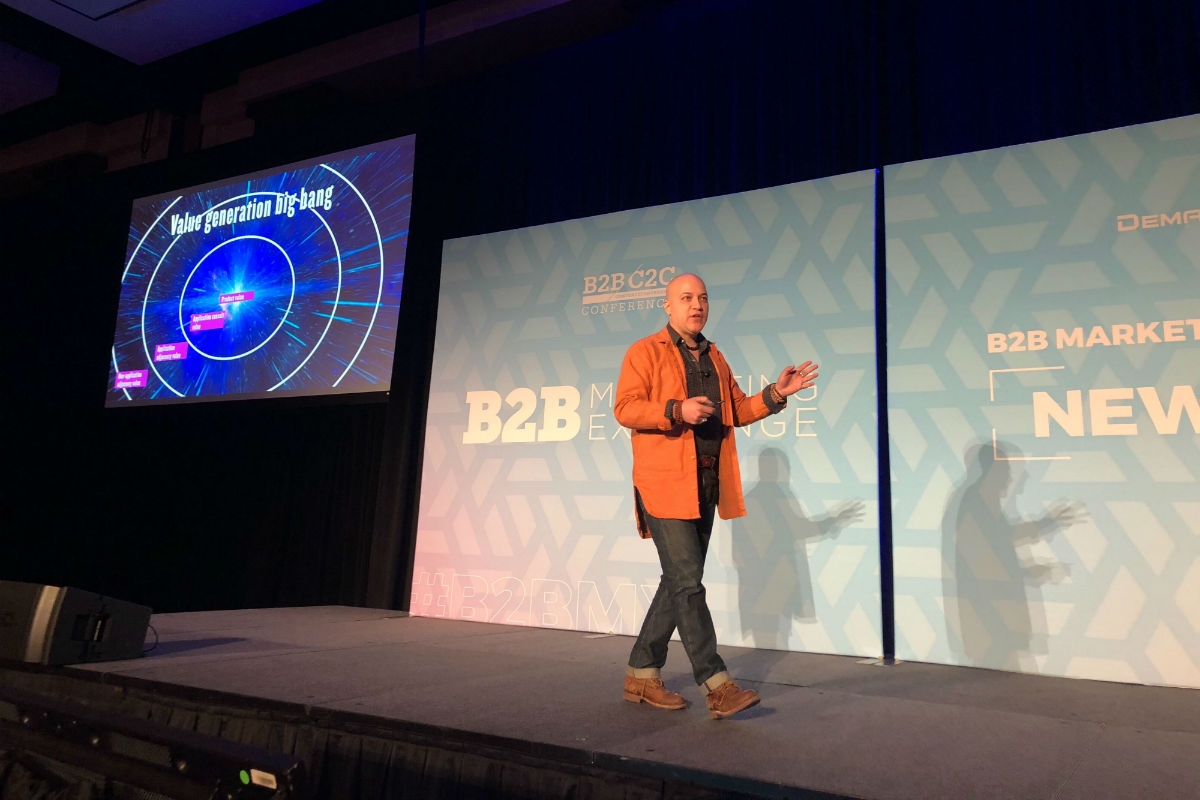Seventy-one percent of B2B marketers rate their company’s overall content marketing success as zero to minimal, according to the Content Marketing Institute. The issue, however, isn’t about creating and publishing content, but rather creating the right content that authentically speaks to buyer needs and pain points. Leveraging inspiration from other organizations, as well as incorporating more authenticity and even humor into your messaging, can position marketing teams to create genuine, personal relationships with buyers.
These topics were discussed at length during the second day of the B2B Marketing Exchange, where more than 1,300 marketing and sales professionals got together to learn how to look at their go-to-market strategies through a new lens. In a keynote session at the B2B Marketing Exchange, Carlos Abler, Leader of Content Marketing and Strategy at 3M, offered a new lens for marketers to overcome their innovation challenges, by looking to non-profits, start-ups and other social entrepreneurship groups for inspiration.
“We’re great at making content that no one wants and that upsets people when they accidentally see it,” said Abler. “We’re not feeling great about it, but we plan to do more.”
According to Abler, B2B marketers are oftentimes too focused on their own business objectives, rather than customer needs and pain points. He suggested marketers take a step back and figure out what they can do to remove friction in people’s lives, help them succeed and propel them forward.
Instead of making “#content that no one wants,” @Carlos_Abler suggests #B2B #marketers look to social entrepreneurship for inspiration pic.twitter.com/RmDF0H2L6d
— Elise Schoening (@elise_schoening) February 27, 2019
“Some of the best frameworks for actually figuring out how to be valuable don’t come from businesses at all,” said Abler. “They come from non-profits, NGOs, civil societies, etc. Those organizations that are really focused on empowering people and building sustainable civilizations.”
To get started, Abler suggested marketers look to the United Nation’s Sustainability Development Goals, which include achieving affordable and clean energy, promoting good health and addressing gender inequality.
“If you use this as a value framework model for how you empower and help people, you’re going to get a lot of really good ideas for your content,” said Abler. “If you get good at this, you will make the best content, and you will help people and help human sustainability in the process and get incredible business results.”
Abler pointed to Aponjon as a prime example of this principle put into practice. The information service provider was started in response to India’s high infant mortality rate. It is designed to send weekly health messages to pregnant women, new mothers and their families via text.
During his #B2BMX keynote, @Carlos_Abler told #marketers to use the UN’s Sustainability Development Goals to create #content that can save the world pic.twitter.com/QhhHHfEBCn
— Elise Schoening (@elise_schoening) February 27, 2019
The initiative addressed a direct need in the community and as a result, was wildly successful. Within a year and a half, 600,000 women in Bangladesh had signed up for the service. Despite offering the service for free to those who cannot afford it, 80% of Aponjon users pay for it.
“We need to learn from other disciplines such as startups, NGOs, social entrepreneurship and innovation in order to avail ourselves of value frameworks and opportunities to actually create content that can make you rich, famous and happy, deliver incredible business results and make the world a better place,” said Abler.
Leveraging Humor During The Crisis Of Trust
One of the other recurring themes throughout the event was the idea of bringing authenticity into messaging and content by putting empathy back into the conversation. According to Tim Washer, keynote speaker, comedian and former marketing strategist at companies such as IBM and Cisco, humor and laughter are great for connecting with authenticity.
“Buyers are currently in a crisis of trust,” Washer said during his keynote session. “As marketers, we need to change things. People don’t feel safe right now, and that should be considered when we try to engage with them.”
“When a brand doesn’t take itself too seriously all the time, it builds trust.” @timwasher killed it at #B2BMX pic.twitter.com/byQ5rjyKRG
— Brian Anderson (@BranderSays) February 27, 2019
A common counterpoint to taking the seriousness out of B2B messaging and content is that no humor can be found in given industries and verticals — such as data infrastructure, government and healthcare. But Washer emphasized that, if a brand doesn’t like laughter in its messaging, ask if their customers like laughter. For example, Washer highlighted his time working at IBM, where he headed the company’s global video content marketing efforts. He shared examples that he thought “would definitely get him fired,” but ended up giving the IBM brand a more personal appeal.
“Comedy is the perfect fit for helping show that vulnerability and gain trust,” Washer said. “When a brand doesn’t take itself too seriously all the time, it builds trust.”
Washer also shared a comedy script formula to help content marketers brainstorm ideas to bring humor into their brand messaging:
- Start with a customer’s pain point;
- Explore what would happen if there was no solution to that problem; and
- Exaggerate that to the Nth degree.
“We’re taking light approaches here, but we’re showing you that we understand [your customers’] pain points. It doesn’t have to be on-the-nose targeted. Just make the connection of the idea to your brand and it’ll stick.”







